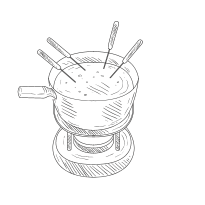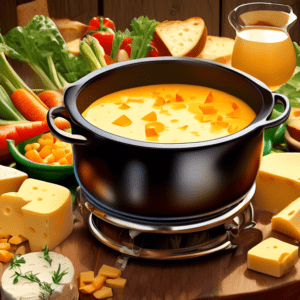Indulge in Creamy Perfection: The Ultimate Guide to Making the Best Cheese Fondue
Introduction: A Culinary Adventure for Your Taste Buds
Prepare to embark on a culinary journey to the heart of Switzerland, where the art of cheese fondue reigns supreme. This delectable dish, renowned for its rich flavors and convivial nature, has captured the hearts and stomachs of food enthusiasts worldwide. In this comprehensive guide, we will delve into the secrets of crafting the perfect cheese fondue, from selecting the ideal ingredients to mastering the art of dipping and swirling. Get ready to impress your guests and treat yourself to an unforgettable dining experience.
The History of Cheese Fondue: A Tale of Alpine Ingenuity
Cheese fondue’s origins can be traced back to the Swiss Alps, where resourceful farmers and herdsmen sought creative ways to utilize their abundant cheese supplies during the long winter months. Melted cheese, combined with readily available ingredients like wine and garlic, provided a hearty and comforting meal that could be easily shared among family and friends.
The first recorded recipe for cheese fondue, known as Käss mit Wein zu kochen (cheese cooked with wine), appeared in a Zurich cookbook in 1693. Over the centuries, fondue gained popularity throughout Switzerland and eventually spread to neighboring countries. Today, it remains a beloved national dish and a symbol of Swiss culinary heritage.
Choosing the Right Cheese: The Foundation of Flavor
Selecting the right cheese is paramount to creating a successful cheese fondue. Swiss cheeses, known for their distinctive flavors and melting properties, are traditionally preferred. Here are some popular choices:
- Emmental: This mild and nutty cheese provides a smooth and creamy base for the fondue.
- Gruyère: Known for its slightly sweet and earthy notes, Gruyère adds depth and complexity to the flavor profile.
- Appenzeller: This robust and tangy cheese brings a sharp edge to the fondue, balancing the richness of the other cheeses.
- Vacherin Fribourgeois: A semi-soft cheese with a delicate, slightly fruity flavor, Vacherin Fribourgeois adds a touch of elegance to the fondue.
Experiment with different cheese combinations to discover your preferred flavor profile. A classic blend consists of equal parts Emmental and Gruyère. For a sharper fondue, incorporate Appenzeller or Vacherin Fribourgeois. Whichever cheeses you choose, ensure they are of high quality and specifically labeled as fondue cheese for optimal melting.
Essential Equipment: Gearing Up for Fondue Success
To create an authentic fondue experience, it’s essential to have the right equipment on hand. Here are the must-haves:
- Fondue Pot: A heavy-bottomed pot, typically made of cast iron, ceramic, or stainless steel, designed to distribute heat evenly and prevent scorching. Fondue pots often come with a stand, a burner, and fondue forks.
- Fondue Forks: Long-stemmed forks with two or three prongs, designed for dipping bread and other ingredients into the fondue pot without losing them in the molten cheese.
- Cutting Board and Knife: For preparing the cheese and other dipping ingredients.
- Wooden Spoon: For stirring the fondue and incorporating the cheese.
- Measuring Cups and Spoons: For accurate ingredient measurements.
- Garlic Clove: For rubbing the inside of the fondue pot, adding a subtle garlic flavor to the fondue.
- White Wine: Dry white wine, such as Sauvignon Blanc or Pinot Grigio, is traditionally used in cheese fondue. The acidity of the wine helps to break down the cheese and create a smooth and creamy consistency.
- Cornstarch or Potato Starch: These starches act as a thickening agent, preventing the cheese from separating and creating a silky texture.
- Kirsch: A clear fruit brandy made from cherries, Kirsch is often added to Swiss cheese fondue for an extra layer of flavor. It can also help to aid digestion.
Step-by-Step Guide: Crafting Your Cheese Fondue Masterpiece
Now that you have gathered your ingredients and equipment, it’s time to create your cheese fondue masterpiece. Follow these steps carefully for guaranteed success:
1. Prepare the Fondue Pot:
Begin by rubbing the inside of the fondue pot with a cut garlic clove. This will impart a subtle garlic flavor to the fondue. Discard the garlic clove.
2. Heat the Wine:
Pour the white wine into the fondue pot and heat over medium heat. Allow the wine to simmer gently, but do not let it boil.
3. Incorporate the Cheese:
Gradually add the grated cheese to the simmering wine, stirring constantly with a wooden spoon. Add the cheese in small handfuls, allowing each addition to melt completely before adding more. This will ensure a smooth and creamy fondue.
4. Thicken with Cornstarch or Potato Starch:
In a small bowl, whisk together the cornstarch or potato starch with a tablespoon or two of the warm wine. Once the cheese has completely melted, slowly drizzle the cornstarch mixture into the fondue pot while stirring constantly. Continue to cook and stir until the fondue has thickened to your liking.
5. Season to Taste:
Season the fondue with salt, pepper, and nutmeg to taste. Be cautious with the salt, as some cheeses can be naturally salty. If desired, add a splash of Kirsch for an extra layer of flavor.
6. Serve and Enjoy:
Transfer the fondue pot to its stand and place it over the burner to keep it warm. Provide each guest with a fondue fork and a selection of dipping ingredients. Encourage your guests to swirl their bread or other dippers in the fondue, ensuring they reach the bottom of the pot to prevent sticking.
The Art of Dipping: Exploring a World of Flavors
The beauty of cheese fondue lies in its versatility. While crusty bread is the classic dipping companion, a world of other delectable options awaits. Consider offering your guests an array of the following:
Bread:
- Crusty baguette, cut into bite-sized cubes
- Sourdough bread
- Rye bread
Vegetables:
- Steamed broccoli florets
- Blanched asparagus spears
- Roasted Brussels sprouts
- Cherry tomatoes
Potatoes:
- Boiled baby potatoes
- Roasted potato wedges
Meats:
- Cooked chicken, cut into bite-sized pieces
- Cooked shrimp
Tips and Tricks for Fondue Perfection:
Here are some additional tips and tricks to ensure your cheese fondue is a resounding success:
- Grate the Cheese: Grate the cheese beforehand to ensure even melting and prevent clumping.
- Use Low Heat: Cook the fondue over low heat to prevent scorching and maintain a smooth consistency.
- Stir Regularly: Stir the fondue frequently to prevent sticking and ensure even heat distribution.
- Adjust Consistency: If the fondue is too thick, add a splash of warm wine. If it’s too thin, whisk together a small amount of cornstarch or potato starch with warm wine and drizzle it in while stirring.
- Don’t Overcrowd the Pot: Overcrowding the pot can cause the temperature to drop, resulting in a thick and gloppy fondue. Encourage guests to dip a few pieces at a time.
- Keep It Warm: Once the fondue is cooked, transfer the pot to a fondue stand and keep it warm over low heat.
- Have Fun: Fondue is a social dining experience. Encourage conversation, laughter, and enjoyment among your guests.
Conclusion: A Culinary Tradition to Savor
Cheese fondue is more than just a meal; it’s a culinary tradition that brings people together. The combination of rich flavors, convivial atmosphere, and endless dipping possibilities creates an unforgettable dining experience. Whether you’re a seasoned fondue enthusiast or a curious newcomer, this comprehensive guide has equipped you with the knowledge and skills to craft your own cheesy masterpiece. So gather your loved ones, prepare your dipping ingredients, and indulge in the creamy perfection that is cheese fondue.

